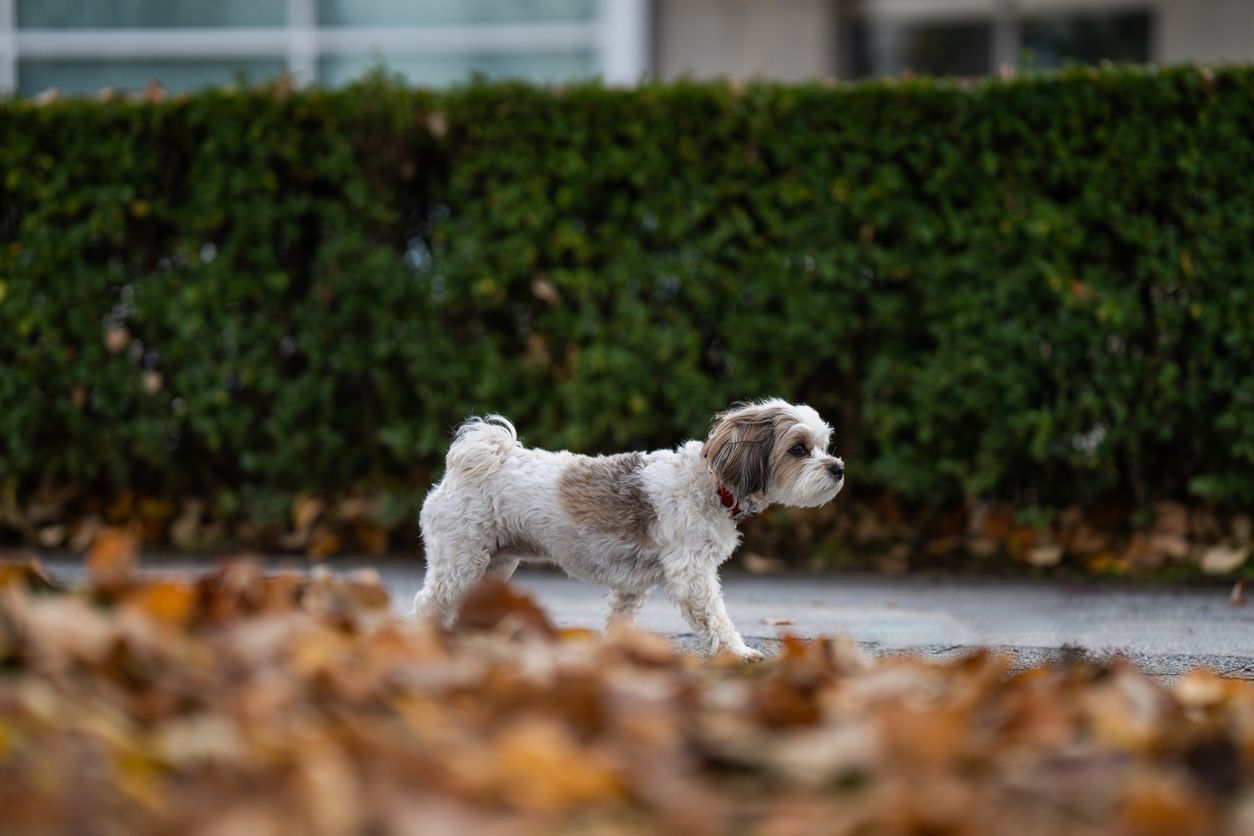What to do if your dog has bloody poop
Signs of blood in a dog’s stool are often alarming to pet parents. It is important to know what bloody dog stool looks like as well as when the symptom indicates an emergency. Read on if you have ever wondered:
- What are the signs of blood in dog poop?
- Why is my dog pooping blood?
- Is the appearance of blood in my dog’s poop an emergency?
- Can I prevent my dog from having bloody stool?
The presence of blood in a dog’s stool is not always an emergency. Mild inflammation of the intestinal tract from straining or passing something abrasive are common causes of small streaks of blood in the stool. However, it is important to pay attention to the amount and type of blood in the stool as some causes of bloody poop in dogs can be life-threatening.
What do bloody stools look like?
Blood in dog stool differs in appearance based on where the bleeding is occurring in the body. It is possible for blood in the stool to have varying characteristics within the same stool sample. There are two types of blood found within dog stool: fresh blood and digested blood.
Fresh blood
Fresh-looking blood present in stool, also known as hematochezia, appears as streaks of bright red blood, jelly-like clots, or as red, liquid diarrhea. The blood has not mixed with stomach acid when it appears this color, indicating that it is coming from the lower gastrointestinal tract. Fresh blood can appear in or around hard stools, normal bowel movements, and diarrhea. It is not uncommon for drops or small clots of fresh blood to pass with frequent straining due to constipation or diarrhea in dogs.
Digested blood
Blood that has passed through the stomach and has been digested has a different appearance than fresh blood. Digested blood in stool, or melena, appears black and tarry and often has a foul odor. Melena indicates the bleeding is occurring in the upper digestive tract, allowing the blood to be digested before it is passed into the stool.
What causes bloody dog poop?
Blood in a dog’s poop is a symptom of many medical conditions or situations rather than a condition itself. The causes of bloody stool in dogs can range from relatively harmless to life-threatening.
Viral, parasitic, or bacterial infections
Contagious diseases and intestinal parasites can cause bloody stool and diarrhea in dogs. The most common infectious diseases that cause blood in stool include:
Young puppies and unvaccinated dogs are most at risk for infectious diseases. “Parvovirus is a common and potentially fatal viral infection that’s especially hard on unvaccinated puppies,” warns Dr. Jo Myers, a Vetster veterinarian. “The disease is highly contagious and causes bloody diarrhea and vomiting.” Dogs must stay up-to-date on vaccinations and parasite prevention to prevent many diseases. Healthy adult dogs often show no symptoms of worms, so regular fecal testing is important.
Dietary indiscretion
Dietary indiscretion occurs when a dog eats something unusual. Dietary indiscretion is a general term for eating something outside of the norm. In some cases, dogs might develop symptoms after eating another pet’s food, table scraps, or garbage. Other dogs may ingest non-food items that cause GI upset. Spoiled food and suddenly changing a dog’s diet can also irritate the digestive tract leading to bloody stools.
Symptoms resulting from dietary indiscretion often resolve on their own if the ingested material is not toxic or does not cause an intestinal obstruction. However, many toxins and poisons cause severe bloody diarrhea in dogs and should always be locked away where dogs cannot reach them. Examples include rat bait poison and human NSAID medications, among others.
Trauma
Trauma and bodily injury can cause blood to appear in the stool. Swallowing something abrasive or blood from a mouth or tooth injury can cause blood to pass through the digestive tract and end up in the stool.
Other medical conditions and diseases
There are many other medical conditions and non-communicable diseases that can cause blood to appear in a dog’s stool. These can include but are not limited to:
- Straining from constipation or diarrhea
- Inflamed anal glands
- Kidney or liver failure
- Intestinal or stomach ulcers
- Cancer
- Immune-mediated hemolytic anemia
- Heatstroke
- Inflammatory bowel disease
- Inherited or immune-related clotting disorders
Excessive straining from a bout of diarrhea or constipation can irritate the colon or rectum, resulting in temporary blood in poop. Diseases and conditions that affect internal organs, such as kidney disease, liver disease, cancers, and heat stroke, can also cause bloody stool. Finally, clotting disorders that cause bloody dog stools can be genetic, such as Von Willebrand disease, or caused by autoimmune diseases.
What should I do if my dog has blood in their poop?
If blood appears in a dog’s poop, look for other symptoms and identify the amount and appearance of the blood. Small amounts of blood in the stool in an otherwise healthy adult dog may be a temporary fluke. Contact a veterinarian if: - Other symptoms are present, such as vomiting, lethargy, change in gum color, loss of appetite - There is a large amount of blood in the stool - The stool is black and tarry - The dog experienced bodily trauma, such as being hit by a car - The bloody stools occur in a young puppy - The dog has an underlying health condition In addition, if the blood does not stop appearing in the stool after a day or two, contact a veterinarian even if the dog does not have any other symptoms. ### Are bloody stools an emergency for dogs? - Severe bloody diarrhea or the presence of digested blood in poop is never normal and indicates a medical emergency that immediately needs veterinary attention.* Dogs passing frequent, small amounts of bloody diarrhea or clots with a jelly-like consistency must also be seen promptly by an emergency vet. Finally, blood that lasts longer than 24 hours in a dog’s feces must be seen by a vet, even if no other symptoms are present.
Can I prevent blood in my dog’s stool?
Many dogs will have occasional blood in their stool that cannot always be prevented. However, there are steps dog owners can take to limit the risk of blood appearing in their pet’s poop. Keep dogs up-to-date on vaccinations and parasite prevention. Avoid suddenly switching foods and offering table scraps. If a dog’s food does need to be changed, slowly introduce the new food to avoid GI upset. Keep trash, rat poison, and other dangerous items your dog may be tempted to chew on or ingest out of reach. Finally, stay up to date with routine wellness checks and testing to help catch underlying health conditions and intestinal parasites so they can be treated before they progress.
If you are concerned about the appearance of your dog’s stool or have questions about the presence of blood in poop, you can ask a veterinarian for advice with a virtual vet appointment on Vetster.
FAQ - What to do if my dog has bloody poop
Is bloody diarrhea an emergency in dogs?
Many dogs experiencing diarrhea may have a small amount of bright red blood in their stools due to excessive straining and irritation to the colon and rectum. A small amount of blood or mucus in diarrhea is common. However, see a vet immediately if there is a large amount of blood or if the dog is experiencing additional symptoms, such as vomiting or lethargy.
What does it mean if my dog has blood in their poop?
A dog may have blood in their poop for several reasons ranging in severity. Constipation, suddenly changing diets, or getting into the trash or human food can all cause bloody stools that may pass on their own. However, the presence of digested or a large amount of blood in the stool is never normal and must be treated immediately.
How do vets treat bloody poop in dogs?
Bloody stool is a symptom with many causes rather than a diagnosis itself. To treat bloody stool, a vet must address the underlying issue causing it. These may vary from relatively harmless to life-threatening.
Does bloody diarrhea in dogs mean they have parvo?
Parvovirus is one of the most common and frightening causes of severe bloody diarrhea in dogs. Young puppies and unvaccinated dogs are most at risk for the disease. Not all bouts of bloody diarrhea are caused by parvovirus.




